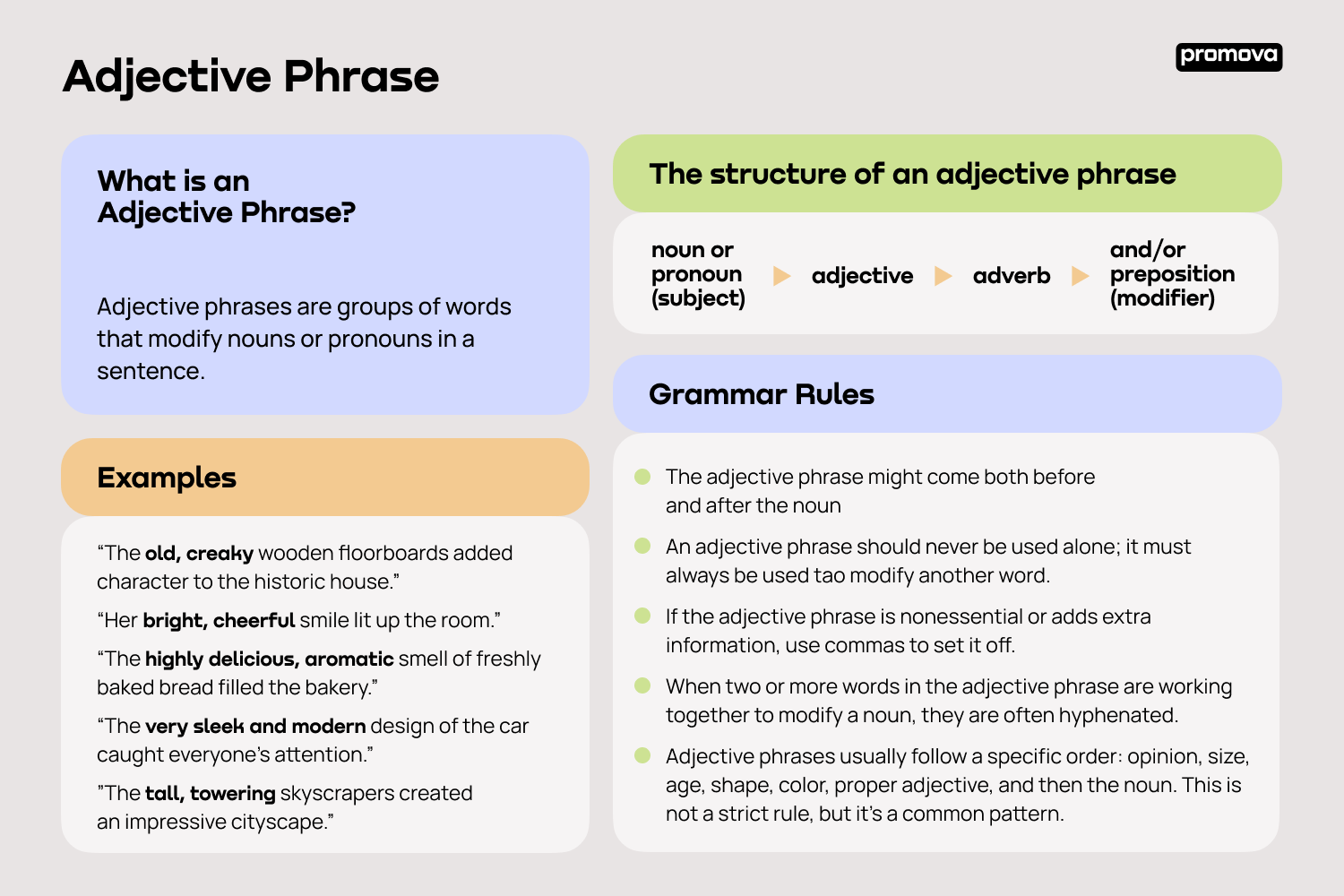Adjective Phrase
Contents
Adjective phrases are one of the most common types of phrases in English grammar. They are used to express ideas, and feelings, or to describe something. In this reference, you will learn more about the concept, find the adjective phrase definition, and see handy examples for your learning.
What is an Adjective Phrase?
Adjective phrases are groups of words that modify nouns or pronouns in a sentence. They usually contain an adjective, adverb, and/or preposition. These phrases may also contain other elements such as articles, conjunctions, and interjections. In some cases adjective phrase may consist of several adjectives, or simply of one adjective.
The adjective phrase can be used in a variety of ways. For example, it can be used to describe a noun or pronoun, to compare two things, or to give an opinion about something. Adjective phrases can also be used to provide more information about a person, place, thing, or idea.
The structure of an adjective phrase typically involves a noun or pronoun (the head) accompanied by one or more adjectives, adverbs, or prepositions as modifiers. So, it's more about the head being modified by these elements rather than the subject. For example, in the sentence “Dan finds it difficult to sell his old, rusty car,” the adjective phrase is “old, rusty.” These two words might be deleted, and the sentence's meaning will be the same. However, they provide a deeper context and understanding of why it is hard for Dan to sell the car.
Adjectival Phrase Examples
Below are some examples of adjective phrases and how they are used in sentences. All adjective phrases are in bold.
- “The old, creaky wooden floorboards added character to the historic house.”
- “Her bright, cheerful smile lit up the room.”
- “The highly delicious, aromatic smell of freshly baked bread filled the bakery.”
- “The very sleek and modern design of the car caught everyone's attention.”
- ”The tall, towering skyscrapers created an impressive cityscape.”
As you can see, the adjective phrase may consist of several words and usually contains at least one adjective. To define an adjective phrase in the sentence, always try to find phrases that could be easily cut from the sentence without changing its meaning.
1
Grammar Rules
When using an adjective phrase, there are a few grammar rules to keep in mind. First, the adjective phrase might come both before and after the noun:
- Before. I love his slightly futuristic car.
- After. The cat, fast and agile, jumped over the fence.
Second, an adjective phrase should never be used alone; it must always be used to modify another word. It exists to give meaning to something else and doesn't have any on its own.
Third, if the adjective phrase is nonessential or adds extra information, use commas to set it off.
- For instance, “My friend, an experienced photographer, captured the stunning sunset.”
Fourth, when two or more words in the adjective phrase are working together to modify a noun, they are often hyphenated.
- For example: The well-known actor received an award.
Finally, adjective phrases usually follow a specific order: opinion, size, age, shape, color, proper adjective, and then the noun. This is not a strict rule, but it's a common pattern.
- For example: “A beautiful, small, antique, round, wooden, Chinese table.”
Identifying adjectival phrases
Adjective phrases modify sentences and always include multiple words. So, to identify an adjective phrase, look for words that modify a noun or pronoun and are made up of more than just a single word.
If you remove an adjective phrase from a sentence, the meaning of the sentence will still remain, but the phrase provides more detail about the noun or pronoun it is modifying.
For example, in the sentence “The tired, but happy children laughed,” the adjective phrase “tired, but happy” modifies the noun “children.” If you remove the adjective phrase, the sentence still makes sense: “The children laughed.” However, without the adjective phrase, there is no information about how the children were feeling.
So if you're ever in doubt, just ask yourself if the phrase is providing more detail about a noun or pronoun in the sentence and can be safely cut from it.
Is there a difference between an adjective phrase and an adjective clause?
Yes, there is a difference between an adjective phrase and an adjective clause. An adjective phrase is made up of two or more words that modify a noun or pronoun, but it does not contain a subject and a predicate (usually a verb). An adjective clause, on the other hand, might contain a subject and a predicate and might act as a separate sentence.
For example, in the sentence “The tired, but happy children laughed,” the phrase “tired but happy” is an adjective phrase because it modifies the noun “children” but does not contain a subject and predicate.
However, if we added a clause to this sentence—such as “who had been playing all day”—it would be an adjective clause because it contains both a subject (“who”) and a predicate (“had been playing”).

Summary
An adjective phrase is a useful tool for expressing ideas and describing things. It might consist of several words. There may be several adjectives, adjectives and adverbs, adjectives and prepositions, or even adjectives and nouns.
When using an adjective phrase, it is important to remember the grammar rules for placement. An adjective phrase always modifies the noun and can't be alone in the sentence. However, it might be cut off the sentence without changing its meaning. With practice, you can learn to master creating descriptive sentences and greatly improve your language skills.
Comments